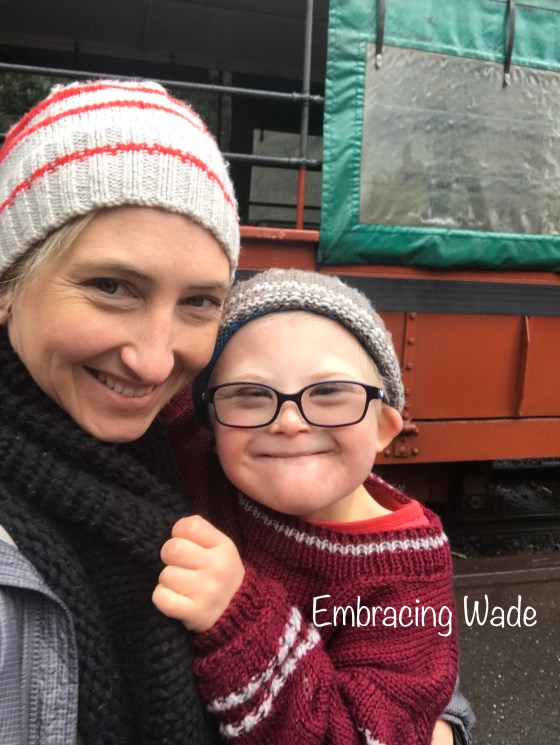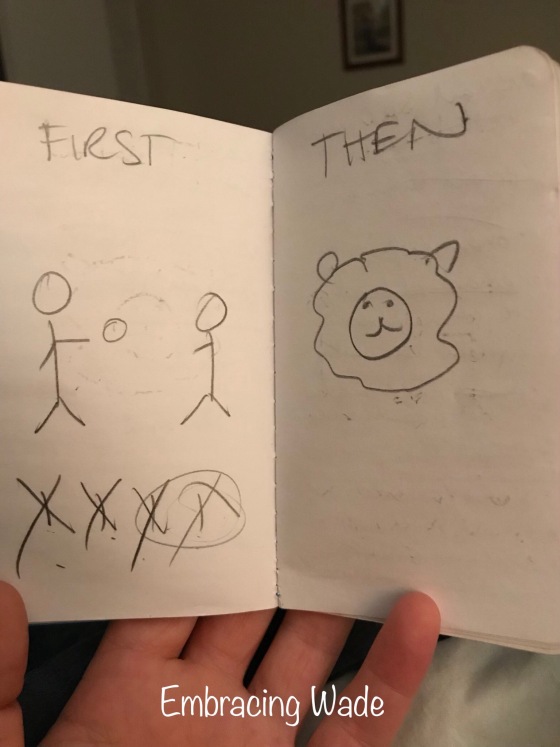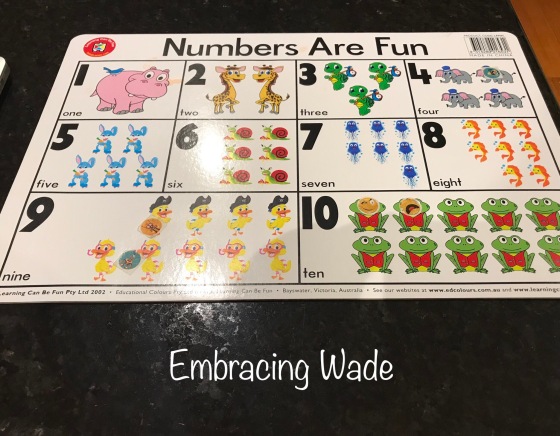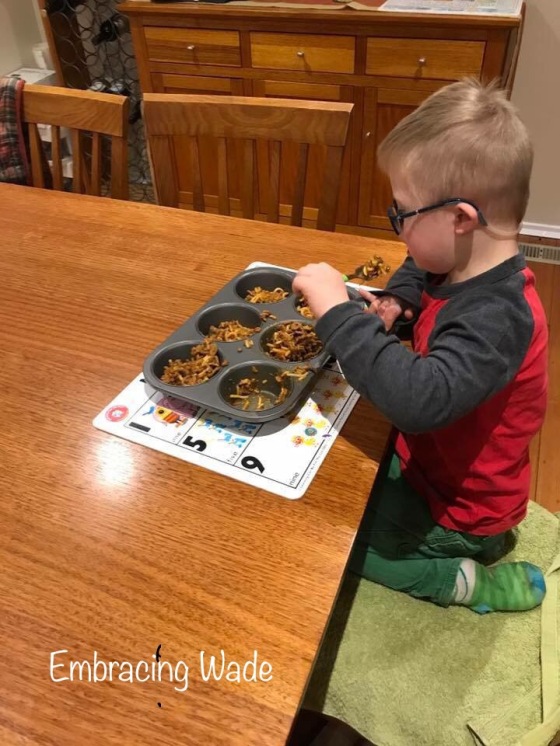
I had to pull over in my car yesterday when I heard the news that Sisto Malaspina was named as the person killed in the Bourke St attack on Friday. I don’t know the offender’s name, nor do I care … Continue reading


I had to pull over in my car yesterday when I heard the news that Sisto Malaspina was named as the person killed in the Bourke St attack on Friday. I don’t know the offender’s name, nor do I care … Continue reading
The Down syndrome community is full of different parents all trying to help their child ‘meet their full potential’, but often they are at odds philosophically – so it can feel like a minefield trying to choose the right path for your child. Add in the Mummy Guilt over all the things you ‘should do’ or ‘should do better’ and this can create a hornet’s nest of passion, paranoia and panic. We know that kids with Down syndrome benefit from some therapy or interventions in the first few years of life…
But which therapies? And when? How much therapy, for how long and who from?
And does it actually have to be ‘therapy’?
Somewhere in the middle of the raging differences of opinion, I have to work out when to intervene in the health, development and education of Wade and when I have to step back and just let him be who is. How much of what I am trying to do for Wade is what all parents do for their children and how much of it is trying to change him to be more ‘acceptable’ in an ableist world?
By working out where my philosophical line is, I can stop the Guilt Train crashing through my life every time a new therapy fad appears.
What is ‘full potential’?
I see this phrase everywhere and it sounds pretty good. Who wouldn’t want ‘full potential’ for their kids? But what is it?
Trying to define it feels like trying to chase a rainbow. However, this phrase is used to justify the use of lots of different therapies.
Here’s the way I look at it…
My muscles have the potential to be five times their current size or larger (for argument’s sake). By not achieving this goal, I am not reaching my muscles’ ‘full potential’. That sounds bad and feels like I am walking away from some great peak of achievement.
But if I look at it another way, what would it take to make my muscles five times larger?
I would probably need to hire lots of professionals (like personal trainers and dieticians) and spend hours and hours a day in the gym. I would have to change my diet dramatically and that might involve giving up chocolate and wine (this argument alone is enough to make my point but I’ll press on!) I might also see a product online promising to increase my bulk and muscle mass by taking enormous quantities of protein or vitamin supplements. This product might not be available in Australia or been tested scientifically for safety and efficacy – but if other people are using it and it helps me reach my ‘full potential’ then I should take it, right? Because if I don’t, then I’m not doing all I could…
I don’t want my muscles to be five times larger. Sure, there are people bigger and stronger than me but does that matter? I go to the gym and keep myself fit but I draw the line on world body building domination because that is not a world I want to spend my time in. It’s not me and I’ve got better things to do with my life than tick that ‘full potential’ box.

What is the cost?
Therapies are expensive but not just in terms of money…although that is definitely a huge factor. Therapies take time and they take energy and I know that I don’t have an endless supply of those. So, if I spend time, money and energy on therapies, that is time, money and energy unavailable for other things.
While the label on the packet of any brand of therapy will suggest that Wade’s life could be improved by using it, what the label doesn’t talk about is all the OTHER things I could have spent my time, money and energy on.
If there is no money for holidays or birthday parties or food for the week, that is something Wade misses out on. If I have to re-mortgage my house to pay for a program then that is financial security and time with mum he misses out on, because I will need to get two jobs to pay for it. If I have seven appointments booked every week and I’m running to different therapists, that is time Wade doesn’t get to spend making friends at the park or investigating the fairies at the bottom of the garden, or learning to cook in the kitchen, counting the glow-in-the-dark stars on his bedroom roof, or any of the other ways learning and development can be incorporated into his everyday life.
If I spend day and night buried in forums, groups and study papers trying to get to the bottom of the value in the latest therapy sweeping through the community that makes me tired; stressed and anxious; and not present in mind, body or spirit for Wade.
The other factor I take into account is whether the therapy stops me from being an instinctive parent. Programs that are too structured and regimented limit my ability to think on my feet and keep my eyes open for the ways that Wade develops in his own way, according to his own interests. There is no point in turning off the music that Wade loves, to spend time doing an intensive speech therapy program that he hates, when he could learn the same thing from his favourite songs if I make a few adjustments.
I decided a long time ago that physios, OTs and speech therapists are there to teach me. I use them to get an understanding of what we are working towards and a list of activities I can use to help Wade get there. Then I take those ideas home and incorporate them into our everyday life. This way, Wade gets to experience life as it is supposed to look, not from the inside of a therapist’s waiting room.
Signing up for every product and therapy that comes my way makes me feel like I look at him as being fundamentally ‘deficient’ and only the therapy will make him capable. This is a tricky one for me to explain where I draw the line but I’ll give it a go…
Wade does have a disability. It takes longer for him to achieve milestones and he does require more support. That takes extra time and a different approach for a kid who doesn’t have a disability. He does require some intervention and I need some help to learn some strategies…
BUT…
If the therapy resembles a steady staircase that we can step up to the next level, at our own pace and in our own time, towards a goal he wants to reach – then I’m into it.
If the therapy resembles us juggling six chainsaws on day one that we can never put down – then no thanks.
Also, if the therapy involves taking him for traumatic blood draws every few months to check how well all my therapies are working… and I have to hold him down while he screams and begs me to stop…then no. Down syndrome on its own is not a disease so I am not going to treat him like he has one. If that kind of intervention is necessary for an added severe health problem then that’s what needs to be done, but if it’s just in the name of chasing the elusive ‘full potential’ rainbow, then no.
What is the therapy and who is the therapist?
They are endless really. The big wide world of therapy options feels like it could swallow you whole sometimes. It is impossible to do them all because…time, money, sanity…so I have to make a choice.
Here’s some of the things I think about when considering a therapy option.
If I’m using a product or a program, I want to know if it is going to be safe and effective. Especially if I’m handing over fists full of dollars for it. If Wade is going to eat it, I want to check the quality of the scientific research behind it or known short and long-term side effects.
Red flags for me are claims about a product that are not supported by good evidence or practitioners that claim a product is supported by evidence when it is not. I am also wary of practitioners who don’t know the difference between quality research and pseudoscience. I understand that not everything in the world can be backed by water-tight science but when someone is selling me something I at least need them to understand the limitations of their product.
Other red flags are practitioners that claim that their therapy is the only one that will work, that their protocol must be followed to the letter and that I can never stop. This feels more like a cult than a therapy to me…
When have I achieved it?
This question is the clincher for me. Let’s say, that I decide to jump in boots-and-all with multiple therapy types. Let’s say that I invest in intensive movement programs, reading programs, speech programs, communication books, diet modifications and supplements and everything in between…
When does it end? Does a flag pop up one day signalling FULL POTENTIAL REACHED! You May Now Go Back to Your Life?
Do I get to put away the supplements and leave the online groups, cancel the appointments and sit down to a nice big bowl of gluten – or will this just be his life forever?
Does ‘reaching full potential’ mean not being able to exist as you are without endless interventions? And what does that do to his sense of self and worth?
This is the line for me.
Can it be achieved in another way?
One of the biggest things I have realised over the past six years is that Wade will learn things whether we have seen a therapist or not. He is learning all the time. He reaches milestones and gathers new skills during times of doing regular therapy and times when we don’t. The key for us when Wade was younger was not how many formal therapy hours we crammed into the week, it was how therapeutic I made his everyday activities. I realised that therapy and products don’t need to come in a box marked ‘special things for special people’ before they will work.
For some reason:
My kid needs ‘speech development exercises’ while others sing nursery rhymes.
While I’m focusing on his ‘spatial awareness development’ as a baby, other new mums just play peek-a-boo.
Kids with a disability use ‘brachiation ladders’ while those without play on the monkey bars at the park.
Plus, these interventions usually come with a huge price tag and a comprehensive program to learn how to use them.
I realised that so much of what all parents do for their children is therapeutic. That’s why nursery rhymes, peek-a-boo and playground equipment have been around for generations – because they are good for kids. All kids! Wade might just need more of them for longer. He also may need a specific therapy type if he is having trouble learning something in the traditional way
– but infinitely more formal therapy doesn’t equal infinitely better results.
I have high expectations for him. I expect him to learn and grow and be a part of the world he lives in. But my role is not to change him so he can reach my idea of his ‘full potential’, my role is to make sure all the doors are open for him so he can go through the ones he wants to. For me it is the difference between the medical model and the social model of disability.
He is capable of learning and experiencing all the things he wants to just the way he is. His potential comes from his 47 chromosomes, not in spite of them. Nor are they something to be conquered, overcome or ameliorated.
This does not mean I’m giving up on him. It means the opposite. It means that I truly believe in him. Just the way he is.

I saw a question posted online a little while back and it really got me thinking… Are we setting our kids up to fail to tell them that they can be anything like Prime Minister or a brain surgeon even … Continue reading
Following on from my last post where I waxed lyrical about why I think Wade behaves the way he does when he is being stubborn, I thought it might be a good idea to list some of the practical things I use when trying to get him to cooperate and move out of the flop and drop stage. The other thing to remember: he is a child. Children are often stubborn and the world is a confusing place for all children.
The important thing about this list is none of them are my ‘guaranteed-to-work’ solutions. Some of these things might have only worked once, or only worked for a short time before never working again. Some of these things might only work for Wade and no one else because I know what his patterns are and what will crack his code at different times. What I have found is that when I have lots of different things to try, it is more likely that Wade will think he has come up with the idea to move on himself. *wink*
This is not always possible but Wade’s stubborn refusal often comes when he is not given enough time to prepare for the thing I want to him to do (like get dressed), or stop doing (like put down the iPad). I can pretty much guarantee that if I walk straight up and tell him what to do, he will refuse, dig his heels in, and not budge. I can try to prevent this by talking a lot about what we are doing and why, or by giving him some time warnings such as telling him that he can watch the iPad for another five minutes and then he needs to put it away. I will then remind him at two or one minutes. Another thing I might do is give him an egg timer or a stop watch which is set to go off after a number of minutes. Now, this doesn’t actually work for me…Ha!…What I mean is, even after repeated warnings he still will not voluntarily put the iPad down or jump up and start getting dressed but it does reinforce what I want him to do, when it is going to happen and why. This means he is more likely to cooperate with the next round of things I try.
2. First/then
This is a simple concept that gets me through a lot of minor refusals (only the minor ones mind you…). Sometimes just explaining to Wade what he needs to do first before he can do the thing he wants to do is enough to help order his thoughts and stop a sit-down protest. A lot of the time, I think he just needs to know what is going on and when we are going to do it. For example, if he thinks we are going to the park but I am asking him to put on his shoes (so we can go to the park) he cracks it because he is being asked to something that is not ‘go to the park’. So, if I say, ‘shoes first, then the park’ it is enough to get him over the line.

3. Use visuals
I didn’t use many visuals with Wade when he was young for his speech development. I found the tools like Boardmaker, PECS and PODD to be awkward and cumbersome for me. Rushing off to find boxes of pictures, flip books and boards to complete a simple sentence meant Wade usually lost interest and the moment of spontaneous and genuine communication was lost. I found that Wade responded better to music, rhyme and song for speech so I left them by the wayside.
The one aspect of these visuals that we did miss out on though was the use of pictures to help create a sense of order for Wade’s mind. Children with Down syndrome can often struggle with mental planning and the ability to hold complex instructions or sequences with many steps in their mind as they move through an activity.
So, I have come to this late, but adding pictures into my instructions is really helping now.
Here are my top 3 methods:
Pictello – This is a social story maker app and has worked wonders for us. The reason I love it is because it uses our own voices, pictures and videos to illustrate a set of instructions for Wade. I use it to show a sequence of steps like getting dressed or highlight an important concept like not going outside the gate at home.
I love that he can help make them and I often record his voice in some of the steps. I can also make them silly or funny using our in-jokes so they are more engaging and he can look through them in his own time because they are all in the one place on his iPad.
The other benefit of these stories is that I can record the audio using words and tones that Wade is familiar with. One down side of this has been, that if I use it too much, he can get a bit fussy about the way the real life activity needs to look if it differs too much from the example we filmed in the making of it. I recommend using it as a part of many strategies instead of making it the only thing you use.

Finished board – I use these boards in the one place in the kitchen and only for a couple of different activities, namely eating meals and getting dressed (my two most dreaded times of the day). My finished board is a very simple home made affair: Two laminated A4 pages stuck on the wall with blue tac, a whiteboard marker and a couple of pictures that I found, cut out and laminated representing breakfast, dinner, getting dressed and brushing teeth.
If there is something that he wants to do that is stopping him from getting dressed or eating his meals, I put that at the end of the board. I just draw a picture of it with the marker instead of having to have infinite pictures representing whatever he might feel like doing.
This way he can see the things he needs to do before he can do his fun thing like helping grandad water the garden or read a book in bed or go to the park etc.
The second board is the ‘finished’ board. Once Wade has eaten his meal, or got dressed or brushed his teeth, he puts the picture onto the finished board; visually counting down to the fun thing.

This photo is from when I thought I could use a favourite toy as the reward…it worked once then never again so now I just draw a picture of what he wants to do after the sequence.
Pad and pen – This is the same as the first/then concept in a way but sometimes I grab a piece of paper and draw how many mouthfuls I want him to eat before he can move on from the table, or quickly draw a first/then sequence in front of him so he can see what I am trying to say. I also have a notebook in my bag that opens out like a book (earlier picture) to reveal side by side pages so I can do a quick first/then drawing of what I want him to do if we are out and about and he is overcome by the bob-goblin of stubbornness.
Another cool visual thing that works well at dinner time is a placemat that has the numbers 1-10 with different animals for each number. 1 hippo, 2 giraffes, 3 turtles etc. I ask Wade whether he wants to eat 6 snails or 7 jellyfish or 10 frogs and let him pick what he is going to eat. Then with either a whiteboard marker or a book of stickers, I cross off or put a sicker on one of the animals as he eats each mouthful. He keeps a very close eye on my accuracy with this and makes sure I don’t miss any mouthfuls “accidentally”. By giving him the power to choose whether he will eat ‘elephants’ or ‘frogs’ and making sure I don’t “forget” to mark one, he often ends up eating his whole meal while trying to prove me wrong. *wink*

4. Make a Deal
This is basically a combination of all of the above but a high-end-UN-level-negotiation-type thing where we run through verbally what I need him to do, what will happen if he does the thing, what consequence will occur if he doesn’t do the thing. Then I give him some options for how he is going to do the thing (choosing his own clothes/shoes/toothbrush–whatever lets him think it is his terribly good idea), what rewards are on the table and so on. This also includes giving a bit of ground on things that aren’t that important. Which is why we often eat breakfast on a picnic rug with a few toys or dinner out of a muffin tin or he wears a superhero costume out of the house for the day. I get a win because he has eaten or he is dressed. He gets a win because he feels like he is calling the shots.

5. Rewards
They work. It’s a fancy word for bribery. I use them liberally when he does the thing I am asking. It might be that grandad gets up and does the chicken dance after he eats a vegetable, it might be hugs and kisses for getting dressed all by himself, it’s often ice cream and chocolate because sometimes that’s what it takes. I’m sure all the good parenting books say that this is wrong and children should be rewarded simply by the innate joy of ‘doing the right thing’ and ‘being a part of something larger than themselves’ but unsurprisingly (if you have read my last post) these sorts of things are just not on Wade’s radar. So I use whatever motivators I need to reinforce the thing I need to get done. I often need a range of things to choose from but #whateverworks
6. Keep calm and stick to the deal
My biggest weakness in all this is the necessity to keep calm. The minute I get frustrated, angry or prone to punishment, I have lost. I am not going to pretend this doesn’t happen. Did I mention he is stubborn and I’m a Taurean?! I definitely lose it but I know it is futile. If I stay calm, stick to the deal and quietly–without shame or anger–follow through on the reward or consequence, then he does understand and will usually come around…I’m not going to say it happens quickly…but we get there in the end. I usually give him a couple of chances to stick to the deal, then I do a countdown which triggers the consequence (read more about that here). The consequence is usually missing out on the thing we are working towards.
Even if he really wants to do something, for some reason he just won’t do the steps in between to get there. Getting dressed and leaving the house is a big one. We could be going to a circus on horseback dipped in chocolate and rolled in fireworks and he still won’t put on his shoes…so he misses out.
My absolute favourite is when–after an hour or more of this negotiation, deal brokering, visual scheduling and every trick up my sleeve to leave the house–we get to the countdown and is misses out.
Then he says, ‘Mummy, I want to go to the [circus on horseback dipped in chocolate rolled in fireworks]’.
So, I say, ‘No worries, put your shoes on and we can go.’
‘Ok mummy!’ He says like I am suggesting this for the first time, puts his shoes on and jumps in the car…
**Aaaarggghhhhhhh!!!!!!!!!** I think to myself.
‘Good job buddy’, I say to him.
7. What else is going on?
I nearly didn’t post this ‘Part 2’ because, although I thought I had some handy tips, nothing…and I mean nothing!…has been working for the last couple of weeks. It took me a while to realise that he is not coping too well with being on holidays. He has no routine, no structure, his usual activities have all stopped for the year and he is drifting aimlessly a bit. I have been really frustrated because now is the time when we get time to go and fun stuff that we don’t always get time to do, like museums and visiting friends, but for him, this puts him out to sea a bit. Sometimes I just have recognise that while I have (in my mind) an amazing day planned with activities or fun, he might just want to stay at home and make his own puppet show out of two sticks in the garden because it is familiar and comfortable.
As I said in my last post. Wade’s stubbornness can be both beautifully illuminating and incredibly frustrating for me. On the one hand I understand that the important things to me and the rest of the world are not necessarily important to him. That he experiences the world differently. I understand that often he can see through pointless rules and ridiculous requests. But on the other hand, there are things we still need to get done and he needs to do them on his own. There are things he needs to learn to stay safe and to join in with other groups of people. And finally, even though I recognise that he is entitled to walk to the beat of his own drum, he doesn’t get a free pass to behave however he likes whenever he likes. We both need to do a bit of work and meet each other in the middle.
So, I hope some of these ideas are helpful and I am happy to hear about other people’s ideas to add to my arsenal.

Wade has many features that I adore. His aquamarine blue eyes. The way he screws up one eye while he thinks. His near-perfect comic timing. There is one characteristic however, that has me beating my head against a brick wall … Continue reading

Hello and welcome to my annual StepUp! for Down syndrome fundraising event. Every year our team, Wade’s Waddlers, attends the annual walk to raise funds for our local Down Syndrome organisation – Down Syndrome Victoria. This year I wanted to … Continue reading

I was sitting up in bed the other night reading my copy of the journal, The Lifted Brow. I was reading it at a ridiculous hour of the night because I often stay up much later than I should. My … Continue reading

In this blog and all of my writings about Down syndrome, I have referred to the condition as ‘Down syndrome’, but the more accurate term is Trisomy 21…3 copies (Tri-)…of chromosome (-somy)…21. In the online community a lot of parents … Continue reading

There’s been a lot going on lately. Time seems to be winging its way away ever more quickly and before I know it, things that need my attention are suddenly standing in front of me. One day you think you … Continue reading

Sometimes Wade is given gifts. Mostly it is for a reason like birthdays and Christmas but occasionally we will receive a ‘Just Because’ gift. ‘Just Because’ gifts are generally lovely because I know that the person giving it to us … Continue reading